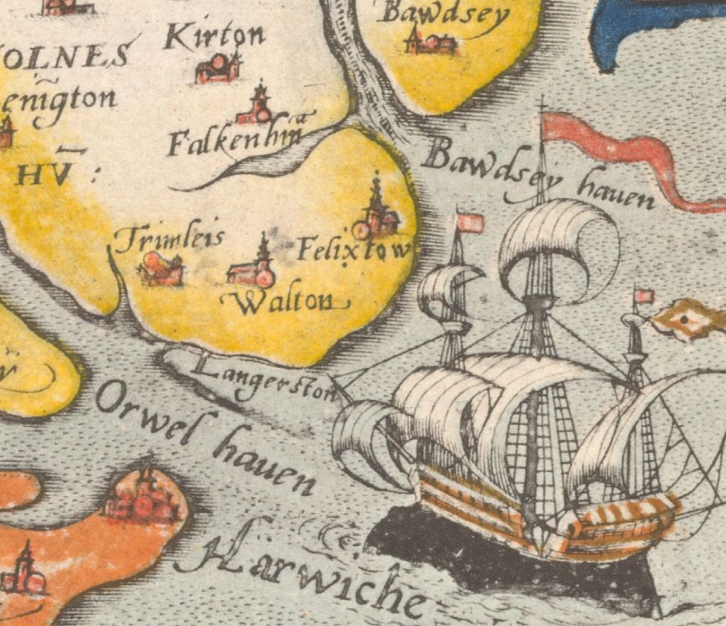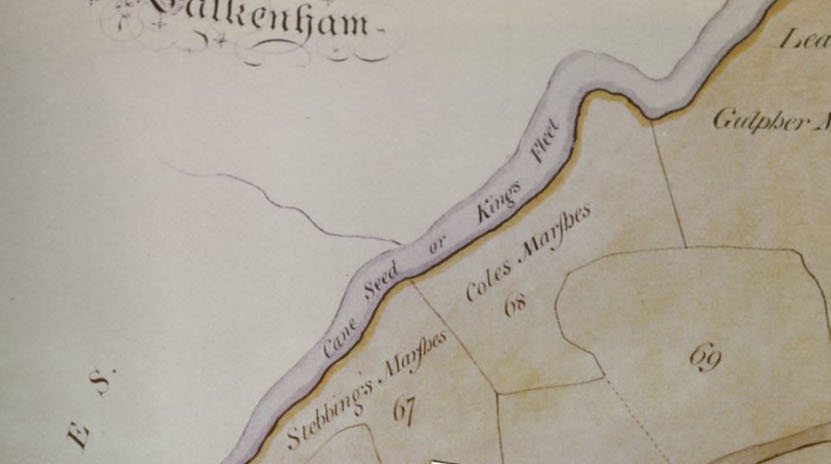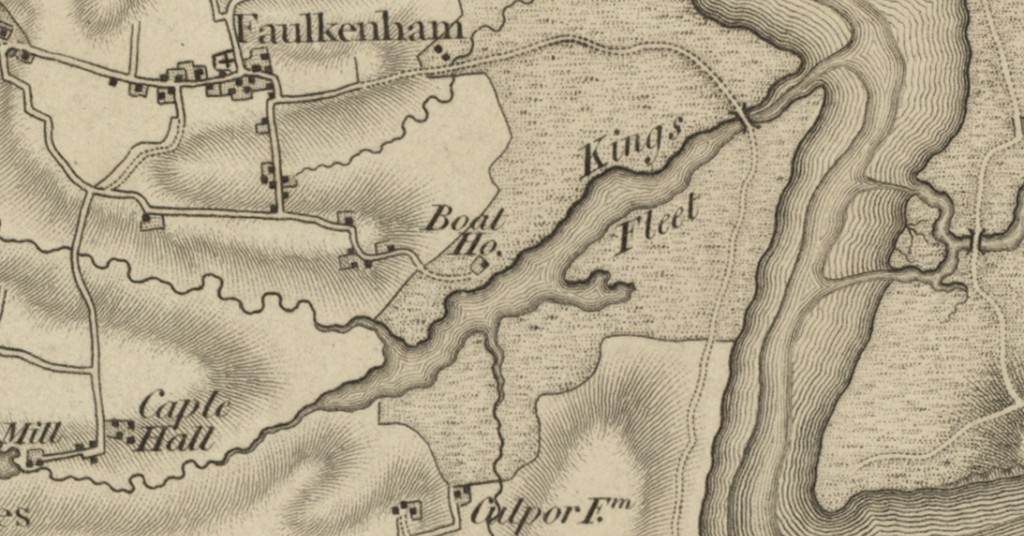In medieval times, before the encroachment of seawalls, the lower Deben was the significant port or haven of Goseford, well described by Peter Wain1See, for an introduction: Wain, Peter. ‘Kingsfleet – The History of Goseford and Kingsfleet’. The Deben, no. Spring 2012.. In that era, there would have been a large expanse of water where there is now salt marsh.
Edward III’s Fleet?
At around that time in 1338, it has been said that Edward III assembled his naval forces at King’s fleet before setting off for Flanders. Whilst a beguiling story, the fleet assembled at Orwell and Great Yarmouth2Fleet assembled at Orwell – Trial by Battle The Hundred Years War, Vol. 1 Trial by Battle v. 1 by Jonathan Sumption. Estimates of its size range from 120 to 400 ships3Based on estimates for Sluys in 1340 including fifteen from the Deben, or Goseford4ANGULUS ANGLIE, A CORNER OF ANGLIA. By V. B. REDSTONE,F.S.A.,F.R.HIST.S. , so it could have been dispersed across both havens. The King and his court spent some time at nearby Walton Hall whilst preparing his forces5Mortimer, Ian. The Perfect King : The Life of Edward III, Father of the English Nation. Vintage, 2008. .
Changing Names
The name of the body of water has changed over the years6W.G.Arnott. The Place-Names of the Deben Valley Parishes. Norman Adlard, 1946. :
1508 WCR Canneysode flete,
W.G.Arnott
1554 WCR Canneyshere fleete,
1640 Caves Hive fleet,
1640 CR Kingsfleeet
1740 Cane Seed Fleet otherwise Kingsfleet.
There was a Walton family of Caney which appears to provide the name.
Both ‘fleet’ and ‘float’ come from the Anglo-Saxon verb ‘fleotan,’ to float or swim. So a fleet is either that which is afloat or a place where vessels can float or a channel where water fleets or runs7Fleet – see Isaac Taylor, Words and Places. There is an alternative interpretation that ‘fleet’, on the East Coast, refers to a shallow area8Robert Simper in the RDA Deben Magazine. . Either version seems appropriate.
Caney to King
The 1575 Saxton Map shows the King’s Fleet, known as Canneyshere fleete at the time. It does not appear to have been closed by sea walls at this stage although that is not conclusive.

The year 1640 appears to be the earliest use of the fleet term, well after Edward III’s time, and ‘fleet’ was used in the sense of a body of water, not shipping. The channel was originally named after a local family, Caney/Canney, whose name could conceivably have been transformed into ‘Kings’. Walton was a royal manor and as Charles I employed Dutch engineers on drainage work that may be the reason for the change to ‘Kings’ appearing in the name by 1640.
The 1711 diary of Sir James Thornhill recorded:
Mav 30th. We went to Kings fleet a kind of Lake abounding with Tench, Bream, Eeles, Perch, Pike, Roach & Gudgeons. 7 or 8 m. from Harwich N.E. Mr. Chapman a good plain honest maltster of Curton, & a man of good fortune, gave us ye diversions of ye fishing & entertained us at his own house afterward very freely, & Dr. Rust lent us his Charriot & 4 im’m Horses all ye day. There are 4 or 5 lakes in this marsh all plenty of fish. Kings fleet is about 2 m. in length, is very fresh, has no visible current into it nor any common. with ye sea, from which it is divided by a large Bank or causeway, whence yon see Bargy whose Tower is tall and a sea mark, there is a ferry.
1711 diary of Sir James Thornhill

Kirby’s Map
A 1738 John Kirby map shows Kings Fleet also as ‘Cane Seed’. It is tempting to think, given the serpentine course of the channel, that the name was a biblical allusion: it would certainly have been an evil channel to navigate. However, the associated family name spoils this hypothesis, and the ‘seed’ refers to sward.
From the Thornhill diary, we know that the fleet was closed to the river by a sea wall. The boathouse shown on later maps was presumably for rowing boats used for fishing.
So, the history and the name co-incidentally fit neatly together but the origins are convoluted.
Footnotes
- 1See, for an introduction: Wain, Peter. ‘Kingsfleet – The History of Goseford and Kingsfleet’. The Deben, no. Spring 2012.
- 2Fleet assembled at Orwell – Trial by Battle The Hundred Years War, Vol. 1 Trial by Battle v. 1 by Jonathan Sumption
- 3Based on estimates for Sluys in 1340
- 4ANGULUS ANGLIE, A CORNER OF ANGLIA. By V. B. REDSTONE,F.S.A.,F.R.HIST.S.
- 5Mortimer, Ian. The Perfect King : The Life of Edward III, Father of the English Nation. Vintage, 2008.
- 6W.G.Arnott. The Place-Names of the Deben Valley Parishes. Norman Adlard, 1946.
- 7Fleet – see Isaac Taylor, Words and Places
- 8
Image Sources and Credits
- 1See, for an introduction: Wain, Peter. ‘Kingsfleet – The History of Goseford and Kingsfleet’. The Deben, no. Spring 2012.
- 2Fleet assembled at Orwell – Trial by Battle The Hundred Years War, Vol. 1 Trial by Battle v. 1 by Jonathan Sumption
- 3Based on estimates for Sluys in 1340
- 4ANGULUS ANGLIE, A CORNER OF ANGLIA. By V. B. REDSTONE,F.S.A.,F.R.HIST.S.
- 5Mortimer, Ian. The Perfect King : The Life of Edward III, Father of the English Nation. Vintage, 2008.
- 6W.G.Arnott. The Place-Names of the Deben Valley Parishes. Norman Adlard, 1946.
- 7Fleet – see Isaac Taylor, Words and Places
- 8
